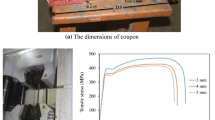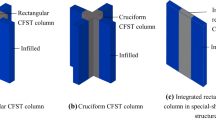Abstract
As a typical compression member, the concrete-filled steel tube has been widely used in civil engineering structures. However, little research on recycled self-compacting concrete filled circular steel tubular (RSCCFCST) columns subjected to eccentric load was reported. In this study, 21 specimens were designed and experimental studies on the stress-strain relationship of were carried out to study the mechanical behaviors. Recycled coarse aggregate replacement ratio, concrete strength grade, length to diameter ratio and eccentric distance of specimens were considered as the main experimental parameters to carry out eccentric compression tests. The corresponding stress-strain relationship curves were used to analyze the influence of concerned parameters on eccentric load-bearing capacity of RSCCFCST columns. The experimental results show that the strain of the eccentric compression stress-strain curves increase with the increase of recycled coarse aggregate replacement ratio and concrete strength grade. With increase of eccentric distance, the ductility of specimens increases while the bearing capacity decreases. Moreover, a phenomenological model of RSCCFCST columns is proposed, which exhibits versatile ability to capture the process during loading. The present study is expected to further understanding the behaviors and to provide guidance of RSCCFCST columns in design and engineering applications.
Similar content being viewed by others
References
Bossink BAG, Brouwers H J H. Construction waste: Quantification and source evaluation. Journal of Construction Engineering and Management, 1996, 122(1–2): 55–60
Hsiao T Y, Huang Y T, Yu Y H, Wernick I K. Modeling materials flow of waste concrete from construction and demolition wastes in Taiwan. Resources Policy, 2002, 28(1): 39–47
Khajuria A, Matsui T, Machimura T, Morioka T. Decoupling and environmental Kuznets curve for municipal solid waste generation: Evidence from India. International Journal of Environmental Sciences, 2012, 2(3): 1670–1674
Atasoylu G, Evci E D, Kaya E, Ergin F, Tikir D, Beser E. The household garbage in the western coast region of Turkey and its relationship with the socio-economic characterstics. Journal of Environmental Biology, 2007, 28(2): 225–229
Xu Y Z, Shi J G. Analyses and evaluation of the behaviour of recycled aggregate and recycled concrete. Concrete, 2006, 7(201): 41–46
Ayora C, Chinchón S, Aguado A, Guirado F. Weathering of iron sulfides and concrete alteration: Thermodynamic model and observation in dams from central pyrenees, Spain. Cement and Concrete Research, 1998, 28(9): 1223–1235
Kikuchi M, Dosho Y, Narikawa M. Application on recycled aggregate concrete for structural concrete. Part 1—Experimental study on the quality of recycled aggregate concrete. In: Proceedings of the International Conference on the Use of Recycled Concrete Aggregates. UK: Thomas Telford, 1998, 55–68
Sagoe-Crentsil K K, Brown T, Taylor A H. Performance of concrete made with commercially produced coarse recycled concrete aggregate. Cement and Concrete Research, 2001, 31(5): 707–712
Stock A F, Hannant D J, Williams R I T, Hobbs D W, Akman M S, Bartoš P. The effect of aggregate concentration upon the strength and modulus of elasticity of concrete. Magazine of Concrete Research, 1980, 32(113): 246–250
Limbachiya M C, Leelawat T, Dhir R K. Use of recycled concrete aggregate in high-strength concrete. Materials and Structures, 2000, 33(9): 574–580
Maruyama I, Sogo M, Sogabe T, Sato R, Kawai K. Flexural properties of reinforced recycled concrete beams. In: Conference on the Use of Recycled Materials in Building and Structures. Bagneux: RILEM Publications SARL, 2004, 526–535
Tao Z, Uy B, Liao F Y, Han L H. Nonlinear analysis of concrete-filled square stainless steel stub columns under axial compression. Journal of Constructional Steel Research, 2011, 67(11): 1719–1732
Hassanein M F, Kharoob O F, Liang Q Q. Behaviour of circular concrete-filled lean duplex stainless steel tubular short columns. Thin-walled Structures, 2013, 68(10): 113–123
Ellobody E, Young B, Lam D. Behaviour of normal and high strength concrete-filled compact steel tube circular stub columns. Journal of Constructional Steel Research, 2006, 62(7): 706–715
Gho W M, Liu D. Flexural behaviour of high-strength rectangular concrete-filled steel hollow sections. Journal of Constructional Steel Research, 2004, 60(11): 1681–1696
Liu L F, Zong J M, Xie Y L. Research status and development trend of concrete filled steel tubular structure. Science and Technology Innovation and Application, 2012, (7Z): 29–30
Yang Y F, Han L H. Experimental behaviour of recycled aggregate concrete filled steel tubular columns. Journal of Constructional Steel Research, 2006, 62(12): 1310–1324
Wu B, Liu W, Liu Q X, Xu Z. Experimental study on the behavior of recycled-concrete-segment/lump filled steel tubular stub columns subjected to concentrically axial load. China Civil Engineering Journal, 2010, 43(2): 32–38 (in Chinese)
Yang Y F, Zhu L T. Recycled aggregate concrete filled steel SHS beam-columns subjected to cyclic loading. Steel and Composite Structures, 2009, 9(1): 19–38
Konno K, Sato Y, Ueda T, Onaga M. Mechanical property of recycled concrete under lateral confinement. Transactions of the Japan Concrete Institute, 1999, 20: 287–292
Yang Y F, Han L H, Wu X. Concrete shrinkage and creep in recycled aggregate concrete-filled steel tubes. Advances in Structural Engineering, 2008, 11(4): 383–396
Yang Y F, Han L H. Compressive and flexural behaviour of recycled aggregate concrete filled steel tubes (RACFST) under short-term loadings. Steel and Composite Structures, 2006, 6(3): 257–284
ACI Committee 318. Building Code Requirements for Structural Concrete (ACI318-05) and Commentary. Farmington Hills, MI: American Concrete Institute, 2005
Han L H. Tests on stub columns of concrete-filled RHS sections. Journal of Constructional Steel Research, 2002, 58(3): 353–372
Xiao J Z, Yang J, Huang Y J, Wang Z P. Experimental study on recycled concrete confined by steel tube under axial compression. Journal of Building Structures, 2011, 32(6): 92–98
Konno K, Sato Y, Kakuta Y. Property of recycled concrete column encased by steel tube subjected to axial compression. Transactions of the Japan Concrete Institute, 1997, 19(2): 231–238
Mohanraj E, Kandasamy S, Malathy R. Behavior of steel tubular stub and slender columns filled with concrete using recycled aggregates. Journal of the South African Institution of Civil Engineering, 2001, 53(2): 31–38
Yang Y F, Han L H. Experimental behaviour of recycled aggregate concrete filled steel tubular columns. Journal of Constructional Steel Research, 2006, 62(12): 1310–1324
Yu Q, Tao Z, Wu Y X. Experimental behaviour of high performance concrete-filled steel tubular columns. Thin-walled Structures, 2008, 46(4): 362–370
Hossain K M A, Lachemi M. Axial load behavior of self-consolidating concrete-filled steel tube columns in construction and service stages. ACI Structural Journal, 2006, 103(1): 38–47
Khayat K H, Paultre P. Structural performance of self-consolidating concrete used in confined concrete columns. ACI Structural Journal, 2005, 102(4): 560–568
Mahgub M, Ashour A, Lam D, Dai X. Tests of self-compacting concrete filled elliptical steel tube columns. Thin-walled Structures, 2017, 110(1): 27–34
Etxeberria M, Vázquez E, Marí A. Microstructure analysis of hardened recycled aggregate concrete. Magazine of Concrete Research, 2006, 58(10): 683–690
Zhang Y M, Zhuang X Y. Cracking elements: A self-propagating strong discontinuity embedded approach for quasi-brittle fracture. Finite Elements in Analysis and Design, 2018, 144: 84–100
Ren H L, Zhuang X Y, Rabczuk T. Dual-horizon peridynamics: A stable solution to varying horizons. Computer Methods in Applied Mechanics and Engineering, 2017, 318: 762–782
Han L H, Yao G H, Tao Z. Performance of concrete-filled thin-walled steel tubes under pure torsion. Thin-walled Structures, 2007, 45(1): 24–36
Zhou S W, Zhuang X Y, Zhu H H, Rabczuk T. Phase field modelling of crack propagation, branching and coalescence in rocks. Theoretical and Applied Fracture Mechanics, 2018, 96: 174–192
Zhou S W, Xia C C. Propagation and coalescence of quasi-static cracks in Brazilian disks: An insight from a phase field model. Acta Geotechnica, 2018, 14(4): 1–20
Zhou S W, Zhuang X Y, Rabczuk T. Phase-field modeling of fluid-driven dynamic cracking in porous media. Computer Methods in Applied Mechanics and Engineering, 2019, 350: 169–198
Acknowledgements
This work was supported by the National Natural Science Foundation of China (Grant Nos. 51578001, 51608003, and 51878002), Natural Science Foundation granted by Department of Education, Anhui Province (No. KJ2015ZD10), Key Research and Development Plan of Anhui Province (No. 1704a0802131), and the Outstanding Young Talent Support Program of Anhui Province (No. gxyqZD2016072). This work was also supported by the Graduate Innovation Research Foundation granted by Anhui University of Technology (Nos. 2016097, 2016094).
Author information
Authors and Affiliations
Corresponding author
Rights and permissions
About this article
Cite this article
Yu, F., Qin, C., Wang, S. et al. Stress-strain relationship of recycled self-compacting concrete filled steel tubular column subjected to eccentric compression. Front. Struct. Civ. Eng. 14, 760–772 (2020). https://doi.org/10.1007/s11709-020-0618-3
Received:
Accepted:
Published:
Issue Date:
DOI: https://doi.org/10.1007/s11709-020-0618-3




